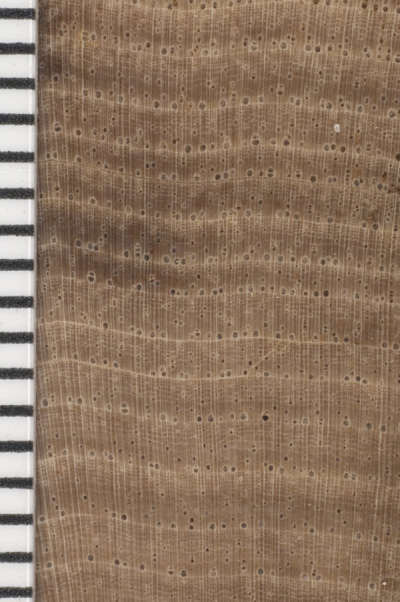Wood Studies
Methods

Results and Discussion
Examination of the wood indicates that only four to five tree species are present in this deposit. Analysis of the thin sections determined that the wood types are Carya (hickory), Ulmus (elm), Acer (maple), and Liquidambar? (sweetgum). The identification of Liquidambar is tentative, since the preservation of the sample was not adequate to positively determine some key diagnostic features in thin section. Additional samples will be needed. There are also a small number of specimens that appear to represent Gleditsia (honey locust). Thin sections will be required to confirm this.
Click to view a Chart showing percentage abundance of wood types at Yakima Ridge locality.
The log cross sections indicate that the trees experienced significant growing stress. Growth rings are generally narrow and tightly spaced. One log that was 20 cm (8 inches) in diameter had over 100 growth rings. Growth stress could be due to environmental factors, low nutrients, or an area with a high water table (Schweingruber, 1996). Modern relatives of the fossil genera found at the Yakima Ridge locality all have species that prefer moist soils and floodplain habitats (Brown & Kirkman, 1990).
The overall area of the excavation is approximately 2,000 m2 (1/2 half acre) in size, resulting in a density of one log per 12.5 m2. The landowner reports that all but two of the excavated logs were found in a vertical orientation within the basalt flow. This was corroborated by photos and videos he had obtained of his excavation efforts and visual observations of log molds still visible in the basalt. The logs extended from the clay/basalt contact to the eroded surface of the flow. Additionally, the tops of several unexcavated logs were visible at the exposed surface of the basalt. Interestingly, there was no evidence of roots or stumps in the in the basalt or in the underlying clay layer. The lack of root traces makes it difficult to assert that the trees grew into the clay, although the vertical orientation of the logs and the unbroken condition of most of the boles would argue against any significant transport of the entombed trees.
The combination of a low diversity forest with closely spaced small diameter trees, stressed growth conditions, and the species composition would indicate that the site represents the colonization of a newly exposed surface, such as a dried lake bed.
